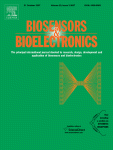
Publication I October 31, 2007
Controlling the surface density of DNA on gold by electrically induced desorption
We report on a method to control the packing density of sulfur-bound oligonucleotide layers on metal electrodes by electrical means. In a first step, a dense nucleic acid layer is deposited by self-assembly from solution; in a second step, defined fractions of DNA molecules are released from the surface by applying a series of negative voltage cycles. Systematic investigations of the influence of the applied electrode potentials and oligonucleotide length allow us to identify a sharp desorption onset at −0.65 V versus Ag/AgCl, which is independent of the DNA length. Moreover, our results clearly show the pronounced influence of competitive adsorbents in solution on the desorption behavior, which can prevent the re-adsorption of released DNA molecules, thereby enhancing the desorption efficiency. The method is fully bio-compatible and can be employed to improve the functionality of DNA layers. This is demonstrated in hybridization experiments revealing almost perfect yields for electrically “diluted” DNA layers. The proposed control method is extremely beneficial to the field of DNA-based sensors.